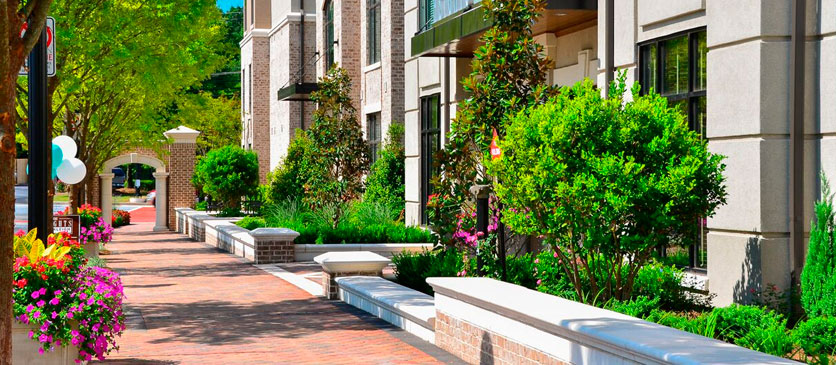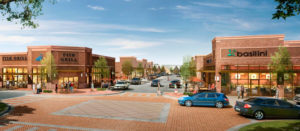The decade of the 1890s was an exciting period of development for Americans. Towns were becoming cities; cities were expanding. This was especially true in Texas, where speculators were drawn from other states. The Houston area attracted thousands of these adventurers, and it was in this climate that Houston Heights began.
As early as 1886, Oscar Martin Carter, a self-made millionaire who had business interests in Nebraska and Colorado, brought to Houston a utopian vision for the approaching twentieth type of town, a planned community where successful entrepreneurs and working people alike could live and work, in health and safety, as neighbors. Compared to Houston, a city plagued by yellow fever and devastating annual floods, Carter chose the ideal spot for his new community. Houston Heights, with an elevation 23 feet higher than downtown Houston, a natural sandy soil, rich vegetation, mature trees and artesian water sources, promised a sanctuary of health and well being.
The land O.M. Carter and his Omaha and South Texas Land Company developed had long been an important area to the city of Houston. This section of Southeastern Texas was first inhabited by Indians of the Coastal Plains. Although a Spaniard had visited the area in the early 16th century, it was not until 1745 that the French from New Orleans and the Spanish began to vie for control of the region. At that time, the area that included much of Houston Heights was controlled by Chief Canos of the Orcoquisacs. Chief Canos successfully played the two European powers against one another for many years.
O.M. Carter had convinced his eastern investors that Houston was destined for growth and the ideal place to invest heavily. Not only did Carter realize that Houston would attract major industries and thus experience. Population growth due to the jobs created by those industries, but he planned for many of the industries to locate in his planned development. He also knew that there would be a great need for housing and he wanted his development to provide the opportunity for home ownership.
Carter’s vision included a transportation system that would bring passengers four miles from Houston to his planned community, a considerable distance in those days. However, in 1890, when most cities the size of Houston already had electric streetcar lines, Houston only had two mule-drawn systems. He arranged for the purchase and electrification of both systems, thus guaranteeing electric streetcars to Houston Heights. His investment gave potential investors the confidence to believe in his dream and invest in his totally planned community. It was also a very profitable venture, since the city was destined for tremendous growth as well.
By 1891, Carter attracted a corps of investors who set up the Omaha and South Texas Land Company. He even convinced some of them to give not just their money, but to live their lives in his utopian city. Carter recognized the desire of the growing middle class to move away from the noise and dirt of the crowded city. The company purchased 1,756 acres of land, and made over $500,000 worth of improvements, including utilities, streets and alleys, as well as parks and schools. The blocks were carefully arranged, some principal streets were covered with shell, and a waterworks system was established. Scattered open spaces supplemented the 60 foot-wide esplanade on Heights
Boulevard. The trees and other natural features that now line the streets were planted during that early period of development. Carter also built a commercial strip at 19th and Ashland Streets and arranged for stores to open there to serve new residents. As was common in most promotional towns, he built a grand hotel (destroyed by fire, 1915) where prospective buyers could stay when they inspected the area.
The founding fathers also built a series of grand Victorian homes along Heights Boulevard, a broad, tree-lined central thoroughfare patterned after Commonwealth Avenue in Boston. Major industrial and commercial concerns were also attracted to Houston Heights by Carter and his associates before the turn of the century, thus completing his plan to develop a totally planned community in which to live and work.
From the outset, Carter planned Houston Heights as a modest community. There were a few land dealers, such as William A. Wilson, who acted as investors and developers in the area. But, in general, Carter sought to prevent speculation. His advertisements and his methods of promotion do not appear to have been aimed at the very wealthy, but at the growing class of white-collar workers, young professionals, and the skilled craftsmen of the working class.
For the full story, read our online story. This story is reprinted with permission from the Houston Heights Association. Visit their website at www.houstonheights.org.




Pingback: 100mg generic viagra blue pill 100 on one side
Pingback: clomid
Pingback: best place to buy cialis online
Pingback: sildenafil 50 mg coupon
Pingback: benefits of ginseng root for men over 40
Abigail2599
7 Aug 2025https://shorturl.fm/x4kdP
Kourtney1313
11 Aug 2025https://shorturl.fm/amSRr
Angela232
11 Aug 2025https://shorturl.fm/UOzBL
Robin4780
11 Aug 2025https://shorturl.fm/MeK9u
1win
12 Aug 2025Официальный Telegram канал 1win Casinо. Казинo и ставки от 1вин. Фриспины, актуальное зеркало официального сайта 1 win. Регистрируйся в ван вин, соверши вход в один вин, получай бонус используя промокод и начните играть на реальные деньги.
https://t.me/s/Official_1win_kanal/4811
Gary3177
16 Aug 2025https://shorturl.fm/EctU6
Tiffany1526
16 Aug 2025https://shorturl.fm/iM4XA
Pingback: sildenafil citrate 25mg
Pingback: buy cialis 5mg
Pingback: best online cialis
Pingback: viagra 25 mg tablet
bet app login
25 Aug 2025Fazer o bet app login no BetAppCassino é super rápido e fácil! Sem complicação pra começar a apostar. Recomendo demais! bet app login
Desirae4455
29 Aug 2025https://shorturl.fm/vyfXt
Ricardo1991
29 Aug 2025https://shorturl.fm/QsGQn
Ana888
12 Sep 2025https://shorturl.fm/aXAKm
Adrian1787
14 Sep 2025https://shorturl.fm/nbjyC
Portal Wielojęzyczny
16 Sep 2025The sentences have a tactile, almost sensory quality. Each phrase can be felt as much as understood, engaging both mind and heart.
Brittany2745
22 Sep 2025https://shorturl.fm/0Cbo0
Sylvia2521
25 Sep 2025https://shorturl.fm/Gwad9
Ethan1469
27 Sep 2025https://shorturl.fm/gA8rj
Holden2173
29 Sep 2025https://shorturl.fm/bjYhR
Isaac30
2 Oct 2025https://shorturl.fm/FW80L
hybrid strain gummies
3 Oct 2025weed delivery tracked for reliability
Hugo3778
3 Oct 2025https://shorturl.fm/8pp97
Ellie2048
5 Oct 2025https://shorturl.fm/MlHjd
Agnes4548
5 Oct 2025https://shorturl.fm/mV3D6
Cynthia925
6 Oct 2025https://shorturl.fm/whE2m
Bret Yeakel
11 Oct 2025connectwiththeworldnow – I’ll return to this, it seems like a project with real potential.
Walton Manion
12 Oct 2025brightvault.click – Colours pop nicely and fonts make reading comfortable all around.
Josue Sarvas
12 Oct 2025nexasphere – This is exactly what I was looking for, amazing!
Eugene Mcintire
12 Oct 2025truegrowth – They provided actionable insights that improved our conversion rates.
Grant Vanier
12 Oct 2025visionmark – Highly recommend for anyone needing quality industrial signage.
Beau Klaassen
12 Oct 2025boldmatrix – Streamlined our product recommendations with their Smart Size Chart.
Alysha Rogan
12 Oct 2025prolaunch – Can’t believe how much this helped me today, thanks!
Jacquelin Geneseo
12 Oct 2025progrid – Fantastic insights, broadened my understanding of the subject.
Philip Overy
12 Oct 2025elitezone.click – Navigation is solid, love how everything is laid out so cleanly.
Lyn Pidro
12 Oct 2025grandlink – Found some great resources I didn’t know about before.
Kareem Sutt
12 Oct 2025ascendgrid – The domain is cool, hope the content lives up to it.
Clay Donnell
12 Oct 2025truelaunch – The layout is clean and reading here feels effortless.
Calandra Sullen
12 Oct 2025brandvision – Found some fresh concepts I’d never thought of before.
Zenobia Boho
12 Oct 2025purehorizon – The content is clear, useful, and doesn’t overcomplicate things.
Rita Postuci
12 Oct 2025elitepulse – Impressed by how current the articles are.
Louie Woodroof
12 Oct 2025innovatek – The tutorials are well structured, made things easy to follow.
Clement Dilcher
12 Oct 2025vectorrise – Their motion graphics look polished and professionally produced.
Jarrett Mathurin
12 Oct 2025smartvibe – Quality posts, they seem well-researched and up to date.
Celia Tomasulo
12 Oct 2025skyvertex – The visuals here are stunning and really grab attention.
Jonathan Littlehale
12 Oct 2025linkcraft – Smooth browsing experience, everything loads fast and clearly.
Ulysses Foussell
12 Oct 2025summitmedia – Friendly tone, feels like a real person behind the posts.
Morgan Wegner
12 Oct 2025visionlane – Solid information, helped me decide what to try first.
Delmer Tanzosch
12 Oct 2025vividpath – The tone feels genuine and not overly salesy, appreciate that.
Leif Kindregan
12 Oct 2025brandcrest – Impressed by the depth in each post, not superficial.
Lamonica Pagnello
12 Oct 2025ultraconnect – The interface is smooth, everything feels responsive and clean.
Gay Heinzmann
12 Oct 2025ascendmark – Really impressed by the design, feels sleek and modern.
Eddie Mullenax
12 Oct 2025urbanshift – Impressed by the depth in each post, very insightful.
Floyd Eviston
12 Oct 2025powercore – Really impressed by how polished everything looks.
Tresa Munsch
12 Oct 2025primeimpact – Very pleasant browsing experience, no clutter.
Fermina Aschmann
12 Oct 2025novaorbit – Quality visuals and writing together make this site stand out.
Frances Bagge
12 Oct 2025urbannexus – Bookmarking this now — looks promising for more insight.
Philip1532
16 Oct 2025https://shorturl.fm/btUid
MichaelThoto
19 Oct 2025cuttingthered – Sharp branding, message delivers confidence and determination effectively.
Donald Kola
19 Oct 2025judiforcongress – Strong campaign site, message feels inspiring and presentation confident.
Hassan Kump
19 Oct 2025freshfashionfinds – Impressed with the product variety and timely delivery.
Jerry Melkonian
19 Oct 2025modernvaluecorner – Quality items for good prices — very happy with my choice.
Leslie Starcic
19 Oct 2025everydaytrendshop.bond – Interesting posts, definitely worth checking every day for new ideas.
Jesse Ketcheside
19 Oct 2025connectforprogress.cfd – Site loads quickly and content feels relevant and fresh.
Loreen Steigerwalt
19 Oct 2025shopwithsmile.cfd – Fast loading site and content feels relevant and engaging always.
Aleisha Arrison
19 Oct 2025investsmarttoday.bond – Enjoyed reading here, very informative and easy to follow.